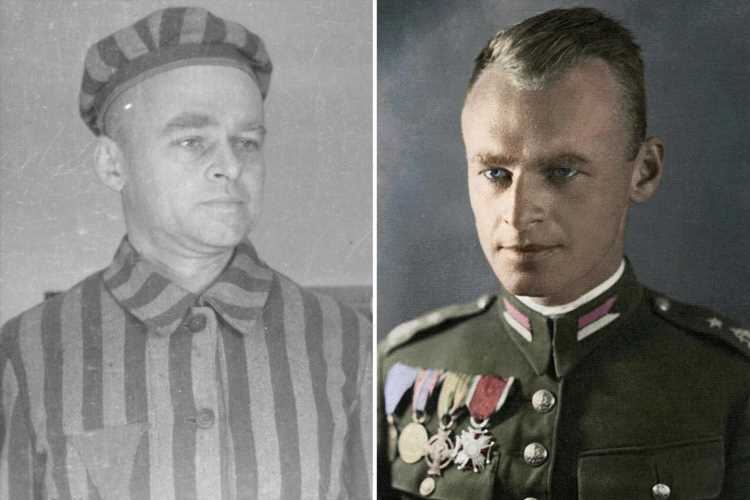A HERO soldier decided the only way to find out the true horrors of Auschwitz was to see for himself – so he volunteered to infiltrate the concentration camp.
Polish officer Witold Pilecki reported back to the Allies about the brutality he witnessed -but his incredible bravery was not acted on many believed his reports were too horrific to be true.
Pilecki was a soldier in the Polish cavalry when his country was invaded by the Germans in 1939.
And he became part of the underground resistance when the Nazis began their brutal occupation.
The Nazis started rounding up anybody deemed to be a threat to them and began sending them to camps such as Auschwitz.
Stories about beatings and torture soon began to emerge which horrified the resistance.
So the Poles who were still fighting decided someone had to be sent in to organise resistance and tell the wider world about the unspeakable horrors.
A staunch patriot and devout Catholic, cavalry officer Pilecki volunteered to leave his wife and children for what was, on the face of it, a suicide mission.
He hatched a plot to get himself arrested by the Nazis in Warsaw and sent to Auschwitz.
And yesterday was the 81st anniversary of his brave plan as his incredible story is told in the book “The Volunteer” by Jack Fairweather
“What Pilecki witnessed in the camp was absolutely unprecedented in human history,” Fairweather told Time.
“He had to figure out what the Nazis were doing with each new step they made towards developing a death factory.
"He couldn’t always grasp the scale of the murder unfolding before him.”
After arriving at the camp and becoming inmate 4859, he began documenting the horrors he saw there and creating a resistance organisation.
By 1942 his organisation realised that gas chambers were being built at Auschwitz for the industrial killing of Jews in the Holocaust.
The gigantic machinery of the camp spewing out dead bodies has claimed many of my friends
His reports from the camp were sent to the Allies using a courier system that the Polish resistance operated throughout occupied Europe.
Pilecki then began working on an audacious plans to liberate Auschwitz.
They included one in which the RAF would bomb the walls and another in which Polish paratroopers would fly in from Britain.
“The gigantic machinery of the camp spewing out dead bodies has claimed many of my friends,” he later wrote.
“We have sent messages to the outside world which were then transmitted back by foreign radio stations. Consequently the camp guards are very angry right now.”
Auschwitz – the factory of death
The largest of the Nazi death camps was the scene of the most appalling mass murder in human history.
During the Holocaust over a million people – the vast majority of them Jews – lost their lives at the sprawling complex
The concentration camp was constructed in the suburbs of the Polish city Oświęcim, near the modern nation's southern border, in 1940.
After annexing that region of Poland during the early stages of World War Two, by April 1940 the Nazi regime needed somewhere to house to Polish political prisoners, with local jails full.
In October 1941 construction began for a second larger camp, Auschwitz II-Birkenau, in the village of Brzezinka three kilometres way.
It was in Birkenau, which held 90,000 prisoners by 1944, that the first gas chamber to murder Jews was made operational in March 1942.
When the mass killings were at their peak, up to 6,000 Jews were being gassed per day, with the cyanide-based pesticide Zyklon B the weapon of choice.
Those not killed in the gas chambers perished from starvation, forced labour and the infectious diseases that spread unchecked through the camps.
Life at Auschwitz was appalling – a true hell on earth.
When they weren't being worked to death, inmates were crammed together in unhygienic, inhumane conditions, and lived with the constant threat of punishment or torture at the hands of the SS guards.
Furthermore, prisoners were subjected to degrading, often fatal medical experiments at the hands of twisted doctors such as the notorious Josef Mengele.
His reports from the camp were sent to the Allies using a courier system that the Polish resistance operated throughout occupied Europe.
Pilecki then began working on an audacious plans to liberate Auschwitz.
They included one in which the RAF would bomb the walls and another in which Polish paratroopers would fly in from Britain.
“The gigantic machinery of the camp spewing out dead bodies has claimed many of my friends,” he later wrote.
“We have sent messages to the outside world which were then transmitted back by foreign radio stations.
"Consequently the camp guards are very angry right now.”
But in 1943 it became clear that the Allies weren’t going to liberate the camp and he and two others escaped at 2am, with the Gestapo in hot pursuit.
After his escape Mr Pilecki was captured fighting in the Warsaw Uprising in 1944 and spent the rest of the conflict in a prisoner-of-war camp.
In July 1945 he joined Free Polish troops in Italy, from where he agreed to return to Poland and gather intelligence on the Soviet takeover of the country.
But after the war he fell foul of the Soviet-installed Polish Communist regime and was arrested and tortured.
He was subjected to a show trial on trumped up charges of espionage and then executed in 1948.
Paying tribute, the Chief Rabbi of Poland, Michael Schudrich, said Pilecki was “an example of inexplicable goodness at a time of inexplicable evil”.
We pay for your stories!
Do you have a story for The Sun news desk?
Email us at [email protected] or call 02077824104. You can WhatsApp us on 07423 720 250. We pay for videos too. Click here to upload yours
Click here to get The Sun newspaper delivered for FREE for the next six weeks.
Source: Read Full Article





